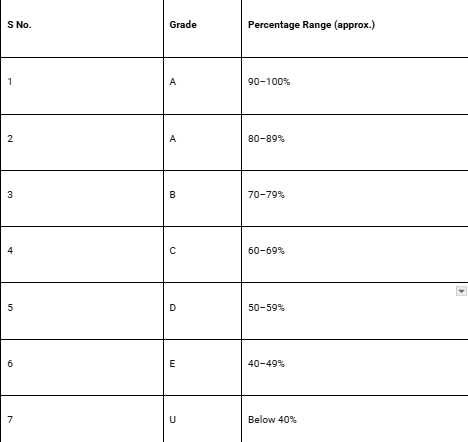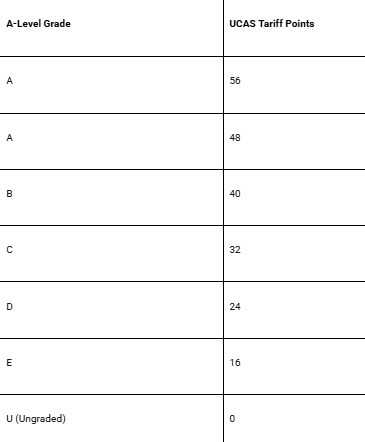The A Level grading system can seem daunting, especially when you're studying the hardest A Levels. For example, if you've just received your results and have no idea what they mean, it can be challenging to move forward and create a plan for your next steps.
Understanding the A Level grading system can clear up any confusion and allow you to focus on achieving your goals, whether that is applying to university or improving your grades for a future resit. This guide will help you get started by explaining how A-Level grades are awarded, what each grade means, and how they compare to other grading systems.
Ucademy's online tutoring UK can help you achieve your objectives. With personalized support from an expert tutor, you can boost your understanding of A Level subjects so you're better prepared for the next round of exams.
What Are A-Levels?

A-Levels, or Advanced Levels, are essential qualifications taken by students in the UK after completing their GCSEs. They typically span two years and usually involve studying three to four subjects. These subjects are chosen based on the student’s interests and future career plans. The grading system for A-Levels ranges from A at the top, down to E as the lowest passing grade. Any result below a C is marked as a U, meaning ungraded and considered a fail. This clear grading scale enables universities and employers to assess a candidate’s academic ability accurately.
A-Levels are highly regarded not only in the UK but internationally. Universities often require specific A-Level grades for admission, making them a crucial step for students aiming for higher education. Employers also value A-Levels as they demonstrate a student’s dedication and knowledge in particular fields. Overall, A-Levels provide a solid foundation for further academic study or entry into the workforce. They challenge students with rigorous academic tests and are recognised for their educational standards worldwide.
For those looking to excel in their A-Level journey, Ucademy offers tailored support to help students achieve their best results. Ucademy stands out as a premier online tuition provider specialising in A-Level support, staffed by experts from top universities such as Oxford. They offer personalised lessons tailored to each student’s needs, combining deep subject knowledge with proven academic strategies.
Book a Free Consultation Today | Free University Readiness Audit
Our proven British Curriculum methodology has helped thousands of students achieve top grades, with expert tutors from top universities, such as Oxford and Cambridge, guiding them every step of the way. Ucademy takes the confusion out of navigating GCSEs, A-levels, 11+, and university applications by creating a personalized roadmap explicitly tailored to your child's goals and learning style.
We provide the structured accountability framework that busy parents need, ensuring your child stays on track to reach their full academic potential and secure their place at a top university. Don't let your child struggle through critical academic years without expert guidance and a clear path to success. Book your free consultation today to get your free university readiness audit and action plan.
A Level Grading System Breakdown

A Levels are a key academic qualification, and their grading system is designed to represent different levels of student achievement. The grades range from A to E, with U indicating a fail mark. Each grade reflects a distinct level of understanding and skill demonstrated by candidates during assessments.
A – Outstanding Achievement
The A grade stands as the pinnacle of academic success in A Levels. It is awarded to candidates who achieve exceptional performance, typically requiring an overall score of at least 90%. This grade signifies not only comprehensive knowledge of the subject but also the ability to critically and effectively apply concepts, demonstrating mastery and deep understanding.
A – Excellent Performance
A grade A reflects a powerful command of the subject. Students consistently awarded this grade demonstrate detailed knowledge and understanding, as well as the practical application of material in their assessments. Achieving an A indicates high-level analytical thinking, the integration of ideas, and proficient use of subject-specific skills.
B – Solid Understanding
Students earning a B grade have demonstrated a good grasp of their subject. This grade indicates a competent application of knowledge and the ability to tackle more complex tasks with some success. It highlights proficiency in critical thinking, problem-solving, and evaluation of information with reasonable confidence.
C – Competent Knowledge
A C grade denotes satisfactory performance and fundamental understanding of the topic. Candidates demonstrate the ability to apply their knowledge in familiar situations, although their depth and analytical skills may be limited. This represents a solid foundation of key concepts and basic skills.
D – Basic Comprehension
The D grade is indicative of a pass but with restricted achievement. It points to a basic understanding of core material, but is often accompanied by notable gaps in knowledge or application. Although the student meets a threshold level of competence, this grade indicates areas that require further development for stronger performance.
E – Minimum Pass
E is the lowest passing grade, signifying the bare minimum level of understanding required. Students who receive an E meet essential criteria but display significant limitations in their knowledge and skill set. Meeting this grade means passing, but with very restricted mastery of the subject.
U – Ungraded (Fail)
A U grade indicates that the candidate has not met the minimum standards for passing. This suggests a lack of understanding and competence in the subject material. Students receiving a U need substantial improvement and may need to retake the exam to demonstrate adequate knowledge and skills.
Understanding these grades helps students, educators, and institutions gauge performance levels and identify areas for improvement or excellence in the rigorous A-Level examinations.
Table Summary of A-Level Grades to Percentage Conversion (2025)

Related Reading
How A Level Grades Are Determined

Understanding how A-Level grades are awarded is essential for students aiming to achieve their best results. The final grade is derived from a blend of different assessment methods designed to evaluate a student’s overall performance in the subject.
Exams
Exams form the cornerstone of A-Level evaluation. Usually scheduled at the end of the course, these written tests assess a student's grasp of the syllabus. Exam questions vary widely, from brief, direct answers to detailed essays, depending on the subject. They test not only knowledge but also the ability to interpret, analyze, and apply concepts.
Coursework
Coursework comprises tasks like assignments, reports, and projects completed during the course timeline. This component enables pupils to showcase skills such as research, critical thinking, and practical application of ideas within the subject matter. The nature of coursework differs by discipline. It might involve essays, lab reports, creative pieces, or investigative write-ups.
Practical Assessments
For subjects, particularly within the sciences, practicals are a vital part of the grading system. These involve conducting experiments or fieldwork, where students demonstrate hands-on skills, interpret data, and connect theory with practical applications. Practical assessments typically occur in controlled environments, and students may be required to submit detailed reports or deliver presentations based on their findings.
Together, these different evaluation methods provide a well-rounded picture of a student's abilities, ensuring that the final A-Level grades fairly reflect both theoretical knowledge and practical skills.
Understanding UMS, Raw Marks, Grade Boundaries, and Official Exam Board Websites

Raw Marks
Raw marks represent the exact scores students obtain on their exams or coursework. These scores are based on the total points allocated to the exam or assignment. For instance, if a test has a maximum of 100 points and a student earns 75, then their raw mark is simply 75. These marks give a direct reflection of individual performance before any standardisation or adjustment.
UMS
The Uniform Mark Scale, commonly called UMS, is a system used to standardise marks across different exam sittings. Because exam difficulty can vary from year to year, converting raw marks into UMS helps maintain grading consistency. Exam boards analyze how students perform overall and how challenging the paper was.
Then, they translate raw marks into UMS points according to a predetermined scale. This means that a raw score in one year might convert to a different UMS score in another year, but both will correspond to the same level of achievement. Ultimately, UMS scores form the basis for final grade decisions, ensuring fairness across examination periods.
Grade Boundaries
Grade boundaries are the minimum UMS scores needed to achieve each grade classification, such as A, A, B, etc. These boundaries are set annually by exam boards after the exams have been marked and the overall results have been analyzed. Factors influencing these boundaries include exam difficulty and the performance of all candidates.
Importantly, there is no limit on the number of students who can attain a particular grade. If multiple students meet or exceed the boundary, they all receive that grade. This prevents any artificial cap on results and guarantees fairness by rewarding everyone who meets the required standards.
Official Exam Board Websites
For accurate and up-to-date information on grade boundaries, raw mark conversions, and official announcements, it is essential to consult the official websites of the exam boards. Leading UK and international exam boards include:
- Cambridge Assessment International Education (CAIE)
- AQA
- Edexcel (Pearson)
- OCR
These sites provide comprehensive resources, including past grade boundaries, exam timetables, and detailed guidance to support students and educators.
Let’s Talk About Ucademy’s Online Tutoring
Our proven British Curriculum methodology has helped thousands of students achieve top grades, with expert tutors from top universities, such as Oxford and Cambridge, guiding them every step of the way. Ucademy takes the confusion out of navigating GCSEs, A-levels, 11+, and university applications by creating a personalized roadmap explicitly tailored to your child's goals and learning style.
We provide the structured accountability framework that busy parents need, ensuring your child stays on track to reach their full academic potential and secure their place at a top university. Don't let your child struggle through critical academic years without expert guidance and a clear path to success. Book your free consultation today to get your free university readiness audit and action plan.
A-Level Grading vs UCAS Tariff Points
Understanding the relationship between A-Level grades and UCAS tariff points is essential for students applying to universities in the UK. While both systems relate to academic achievement, they serve different purposes and operate on distinct scales.
What Are A-Level Grades?
A-Level grades represent a direct evaluation of a student's performance in specific exams taken at the end of their course. The grades range from A (the highest) down to E (the minimum passing grade), with U indicating an unclassified or fail grade. These grades reflect the knowledge and skills demonstrated in the assessments and are awarded by individual examining boards.
In the assessment process, percentages reflect raw scores. Systems such as the UMS (Uniform Mark Scale) and PUM (Percentage Uniform Marks) have historically standardized marks across different exam versions and boards, ensuring fairness. For instance, the threshold for an A grade often lies between 80% to 90% PUM, depending on the board. Notably, most UK boards now use linear A-Level exams rather than modular structures that relied on UMS, although Cambridge International still applies PUM standards.
What Are UCAS Tariff Points?
UCAS tariff points convert a wide range of Level 3 qualifications, such as A-Levels, BTECs, and Scottish Highers, into a numerical scoring system. Universities use this system to compare diverse qualifications across awarding bodies on a like-for-like basis during the admissions process.
Each A-Level grade corresponds to a specific UCAS point value, allowing universities to set entry requirements that can effectively combine multiple qualifications. This system also facilitates the comparison of qualifications with differing grading scales, providing flexibility and fairness in assessing applicants.
How A-Level Grades Convert to UCAS Tariff Points
Here is the conversion table for A-Level grades based on the 2025 UCAS tariff system:

Related Reading
- Is Maths A Level Hard
- Is IB Harder than A Levels
- Is History A Level Hard
- Is Geography A Level Hard
- How to Get an A in Level Chemistry
A-Level Grades vs International Grading Systems

Understanding how A-Level grades compare to different international grading systems is essential for students, parents, and educators navigating education choices or university applications. This overview highlights key distinctions and similarities between the UK’s A-Level system and various global grading models.
Grading Scales (Letters vs Numbers)
A-Level qualifications primarily use a letter-based grading scale ranging from A (the highest) to E (the lowest passing grade). This approach is straightforward and focuses on distinct achievement levels.
In contrast, international grading systems often rely on numerical scores or percentages. For instance, the US typically uses letter grades combined with Grade Point Averages (GPAs), while other countries may report percentages or a mix of both. Systems such as the International Baccalaureate (IB), CBSE (India), and Cambridge IGCSE often translate performance into numbers, with percentage thresholds defining each grade.
Pass and Fail Benchmarks
While A-Levels require a minimum letter grade of E to pass, the exact pass/fail cut-off differs in other systems, often expressed as a percentage. For example, some countries set the pass mark around 40%, whereas others might require 50% or higher to meet the passing criteria. This variation means that a student’s performance needs to be interpreted relative to the specific system's standards.
The Role of GPA
A-Level results do not employ a Grade Point Average (GPA) system; each subject is graded individually with letter grades provided. Conversely, many international education systems incorporate GPA calculations to summarize a student’s overall academic standing, especially in contexts such as US high schools and universities. GPA helps in providing a cumulative performance score, which A-Levels do not produce directly.
Comparing Specific International Systems
International Baccalaureate (IB)
Uses a point-based system from 1 to 7 per subject, with additional core components affecting the total diploma score. Performance is numerical but accompanied by descriptive bands.
CBSE (India)
Primarily percentage-based, with pass marks generally set at 33%-35%, depending on subjects.
Cambridge IGCSE
Similar to A-Levels, it uses letter grades (A to G), but the grading criteria and scales are tailored to the GCSE level, not advanced studies.
A-Level vs IB, CBSE, and Cambridge IGCSE

Educational systems such as A-Level, International Baccalaureate (IB), CBSE, and Cambridge IGCSE each offer unique curricula and structures, catering to diverse learning needs and aspirations. Understanding their distinctions is crucial for making informed academic choices.
What are A-Levels?
A-Levels, short for Advanced Level, are a traditional UK-based pre-university qualification typically completed between the ages of 16 and 18. Students usually select three to four subjects, allowing for in-depth specialization in areas of interest or academic strength. Coursework is primarily examination-centric, with grades ranging from A (top) to E (passing) and U (fail).
A-Levels are recognized internationally and provide a focused path ideal for students who have clear subject preferences or career goals. Their modular nature fosters in-depth knowledge, making it especially appealing for those who prefer concentrated study over a broad curriculum.
What is the International Baccalaureate (IB)?
The IB Diploma Programme is a holistic and rigorous two-year curriculum combining the study of six subjects across different disciplines, including languages, sciences, humanities, maths, and the arts. Beyond academics, it mandates core components like Theory of Knowledge, Extended Essay, and Creativity, Action, Service (CAS), which foster critical thinking and social responsibility.
Grades are awarded on a point system up to 45, with 74 being top and less than 4 failing. IB demands a broad skill set and workload management, offering a balanced mix of exams and internal assessments. It suits students who thrive with variety and have a global outlook.
What is CBSE?
The Central Board of Secondary Education (CBSE) is an Indian national curriculum with a practical and streamlined syllabus that emphasizes subjects such as science, mathematics, and languages. It follows an alphabet-based grading system (A, A, B, C, D, E, U, etc.) and is particularly aligned with national entrance examinations, making it a popular choice in India.
CBSE is viewed as easier relative to other boards, focusing more on rote learning and theoretical knowledge. It is flexible within India for school transfers and well-suited for students aiming for engineering or medical entrance exams domestically.
What is the Cambridge IGCSE?
The Cambridge International General Certificate of Secondary Education (IGCSE) is an international qualification typically completed at Grade 10. It paves the way for A-Level study or other advanced curricula. The IGCSE offers over 70 subjects with a flexible curriculum designed to encourage practical application, problem-solving, and global perspectives.
Grading ranges from A to U, with A being the highest. The curriculum combines theoretical understanding with skill development, making it recognized worldwide and suitable for students seeking international university pathways.
We provide the structured accountability framework that busy parents need, ensuring your child stays on track to reach their full academic potential and secure their place at a top university. Don't let your child struggle through critical academic years without expert guidance and a clear path to success. Book your free consultation today to get your free university readiness audit and action plan.
Benefits of Understanding the Grading System

Evaluating Academic Performance
Understanding the A Level grading system helps students, educators, and parents decode academic performance. A well-structured grading system offers a standardized approach to assessing student performance. It helps measure how well learners meet academic expectations and provides constructive feedback to encourage continuous growth. This consistent evaluation also opens doors for future educational and professional opportunities.
Recognizing Strengths and Weaknesses
Academic Gaps. By analyzing A Level grades, students can pinpoint which subjects or skills they excel in and which require additional effort. This clarity empowers learners to allocate their time and energy more effectively, focusing on areas that need improvement while building on their strengths.
Enabling Informed Decisions
Educators rely on grading data to tailor curricula, select instructional methods, and provide targeted support. Understanding A-Level grades helps teachers make informed decisions that better address student needs, promoting a more personalized and effective learning experience.
Providing Appropriate Support
Parents and teachers who understand the A Level grading system can better identify when a student might require extra help or encouragement. This awareness allows them to offer timely guidance and resources, ensuring students stay on track academically.
Assessing Learning Outcomes
A Level grades serve as indicators of how well students are absorbing and applying knowledge. Educators can utilize this insight to refine their teaching methods, assign suitable homework, and engage students in meaningful activities that foster a deeper understanding.
Monitoring Academic Progress
Tracking A-Level grades over time enables parents and teachers to observe trends in a student's academic progress. Early detection of challenges or declines enables prompt intervention, promoting continuous development and success.
Related Reading
- How to Revise Physics A Level
- How to Revise Psychology A Level
- How to Revise a Level Biology
- How Many A Levels Can You Take
- How to Revise A Level History
Book a Free Consultation Today | Free University Readiness Audit

The A Level grading system can be confusing, especially for students new to the process. A Levels are graded from A to E, with A being the highest grade and E being the lowest. Ucademy helps students understand the grading system and what each grade means for their academic future and university applications. For instance, achieving an A or B at A Level is crucial for gaining admission to a top university, particularly for competitive courses such as medicine and law. Our expert tutors will help your child on their journey to achieving the best possible A Level grades.
What Is The A-level exam Structure?
Before students can even think about the A Level grading system, they need to understand the exam structure. A Levels are rigorous qualifications that demand dedication and hard work. The A Level structure was revised in 2015, and now students will sit all their exams after two years of study, with no modules or retake opportunities. This means that any mistakes or poor performance in early assessments can have serious consequences for final A-Level grades. The new linear structure can be daunting for students, but Ucademy tutors provide the support and guidance needed to help students excel in their A Level exams.
Related Reading
- How to Revise Psychology A Level
- How to Revise Physics A Level
- How to Revise A Level History
- How to Revise a Level Biology
- How Many A Levels Can You Take






